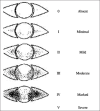A Clinical Study of Meibomian Gland Dysfunction in Patients with Diabetes
- PMID: 26692718
- PMCID: PMC4660533
- DOI: 10.4103/0974-9233.167827
A Clinical Study of Meibomian Gland Dysfunction in Patients with Diabetes
Abstract
Aims of the study: To study the frequency of meibomian gland dysfunction (MGD) in patients of diabetes mellitus with dry eye.
Materials and methods: A case-control cross sectional study.
Sampling: Purposive random sampling. Totally, 200 eyes of 100 patients of diabetes mellitus and an equal number of eyes of normal subjects as control, who were gender and age matched and all of whom were symptomatic for dry eye were assessed for MGD by noting the symptoms and determining the meibomian gland expression scale for volume and viscosity, and ocular surface staining with Lissamine green, and Fluorescein sodium. All the subjects were graded for the severity of MGD. The results were compared in both the groups to ascertain whether the frequency of MGD in diabetics is significantly more as compared to nondiabetics.
Statistical analysis: The data were analyzed by Chi-square test for significance. P < 0.05 was considered as statistically significant.
Results: There was a significant increase in the frequency of MGD in diabetics as compared to the nondiabetics.
Conclusion: Diabetes mellitus is associated with MGD.
Keywords: Dry Eye; Meibomian Gland Dysfunction; Meibomian Gland Expression Scale.
Figures
Similar articles
-
A standardized visual scale for evaluation of tear fluorescein clearance.Ophthalmology. 2000 Jul;107(7):1338-43. doi: 10.1016/s0161-6420(00)00101-9. Ophthalmology. 2000. PMID: 10889108
-
Increased Tear Fluid Production as a Compensatory Response to Meibomian Gland Loss: A Multicenter Cross-sectional Study.Ophthalmology. 2015 May;122(5):925-33. doi: 10.1016/j.ophtha.2014.12.018. Epub 2015 Jan 24. Ophthalmology. 2015. PMID: 25626757
-
Efficacy of diagnostic criteria for the differential diagnosis between obstructive meibomian gland dysfunction and aqueous deficiency dry eye.Jpn J Ophthalmol. 2010 Sep;54(5):387-91. doi: 10.1007/s10384-010-0858-1. Epub 2010 Nov 5. Jpn J Ophthalmol. 2010. PMID: 21052898
-
Intense pulsed light (IPL) therapy for the treatment of meibomian gland dysfunction.Cochrane Database Syst Rev. 2020 Mar 18;3(3):CD013559. doi: 10.1002/14651858.CD013559. Cochrane Database Syst Rev. 2020. PMID: 32182637 Free PMC article.
-
Improving awareness, identification, and management of meibomian gland dysfunction.Ophthalmology. 2012 Oct;119(10 Suppl):S1-12. doi: 10.1016/j.ophtha.2012.06.064. Ophthalmology. 2012. PMID: 23034341
Cited by
-
Meibomian Glands and Tear Film Findings in Type 2 Diabetic Patients: A Cross-Sectional Study.Front Med (Lausanne). 2022 Apr 5;9:762493. doi: 10.3389/fmed.2022.762493. eCollection 2022. Front Med (Lausanne). 2022. PMID: 35479935 Free PMC article.
-
Candidate Molecular Compounds as Potential Indicators for Meibomian Gland Dysfunction.Front Med (Lausanne). 2022 May 24;9:873538. doi: 10.3389/fmed.2022.873538. eCollection 2022. Front Med (Lausanne). 2022. PMID: 35685417 Free PMC article. Review.
-
Assessment of Ocular Surface Damage during the Course of Type 2 Diabetes Mellitus.J Ophthalmol. 2018 Jul 15;2018:1206808. doi: 10.1155/2018/1206808. eCollection 2018. J Ophthalmol. 2018. PMID: 30116624 Free PMC article.
-
Identifying Meibomian Gland Dysfunction Biomarkers in a Cohort of Patients Affected by DM Type II.Vision (Basel). 2023 Mar 24;7(2):28. doi: 10.3390/vision7020028. Vision (Basel). 2023. PMID: 37092461 Free PMC article.
-
Noninvasive ocular surface analyzer as an adjunct in diagnosis and estimating prevalence of meibomian gland dysfunction: Hospital-based comparative study.Indian J Ophthalmol. 2022 May;70(5):1539-1545. doi: 10.4103/ijo.IJO_2245_21. Indian J Ophthalmol. 2022. PMID: 35502020 Free PMC article.
References
-
- Research in dry eye: Report of the research subcommittee of the International Dry Eye Work Shop (2007) Ocul Surf. 2007;5:179–93. - PubMed
-
- Wild S, Roglic G, Green A, Sicree R, King H. Global prevalence of diabetes: Estimates for the year 2000 and projections for 2030. Diabetes Care. 2004;27:1047–53. - PubMed
-
- Gutgesell VJ, Stern GA, Hood CI. Histopathology of meibomian gland dysfunction. Am J Ophthalmol. 1982;94:383–7. - PubMed
-
- Lambert DW. Physiology of the tear film. In: Smolin G, Thoft RA, editors. The Cornea. 3rd ed. Noida, India: Lippincott Williams and Wilkins; 2001. p. 439.
Publication types
MeSH terms
Substances
LinkOut - more resources
Full Text Sources
Other Literature Sources
Medical
Research Materials


